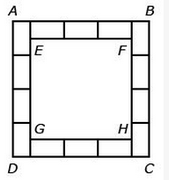In the diagram above, the fourteen rectangular tiles are all identical. What percent of the area of rectangle ABCD is covered by the tiles?
(1) ABCD is a square.
(2) EFGH is a square.
OAD
Hi Experts ,
Please explain.
Thanks,
SJ
fourteen rectangular tiles
This topic has expert replies
- MartyMurray
- Legendary Member
- Posts: 2131
- Joined: Mon Feb 03, 2014 9:26 am
- Location: https://martymurraycoaching.com/
- Thanked: 955 times
- Followed by:140 members
- GMAT Score:800
Statement 1: ABCD is a square.
Let the length of each tile be l and the width be w.
If ABCD is a square, then AB = AD.
So 3l + 2w = 4l and 2w = l.
EG = 4l - 2w = 3l.
So EG = EF, meaning EFGH is also a square, and has sides 3w.
Area ABCD = (4l)² and area EFGH = (3L)².
We don't have to do the math at this point, but we could find the ratio of 16l²:9l² = 16:9.
Sufficient.
Statement 2: EFGH is a square.
If EFGH is a square, then 3l = 4l - 2w. So l = 2w.
Given that l = 2w, can show that ABCD is a square with sides 4l, and we already know that once we do that we can determine the ratios of the areas.
Sufficient.
The correct answer is D.
Let the length of each tile be l and the width be w.
If ABCD is a square, then AB = AD.
So 3l + 2w = 4l and 2w = l.
EG = 4l - 2w = 3l.
So EG = EF, meaning EFGH is also a square, and has sides 3w.
Area ABCD = (4l)² and area EFGH = (3L)².
We don't have to do the math at this point, but we could find the ratio of 16l²:9l² = 16:9.
Sufficient.
Statement 2: EFGH is a square.
If EFGH is a square, then 3l = 4l - 2w. So l = 2w.
Given that l = 2w, can show that ABCD is a square with sides 4l, and we already know that once we do that we can determine the ratios of the areas.
Sufficient.
The correct answer is D.
Marty Murray
Perfect Scoring Tutor With Over a Decade of Experience
MartyMurrayCoaching.com
Contact me at [email protected] for a free consultation.
Perfect Scoring Tutor With Over a Decade of Experience
MartyMurrayCoaching.com
Contact me at [email protected] for a free consultation.
GMAT/MBA Expert
- Brent@GMATPrepNow
- GMAT Instructor
- Posts: 16207
- Joined: Mon Dec 08, 2008 6:26 pm
- Location: Vancouver, BC
- Thanked: 5254 times
- Followed by:1268 members
- GMAT Score:770
Target question: What percent of the area of rectangle ABCD is covered by the tiles?
Statement 1: ABCD is a square
IMPORTANT: Once we know that ABCD is a square, we also know that EFGH is a square. Notice that if you take square ABCD and "shave" off the same amount (i.e., the width of each rectangle) from the four sides, we get another square (EFGH).
Let L = length of one rectangle.
Side AD has length 4L, which means all four sides of square ABCD have length 4L.
So, the area of ABCD = (4L)(4L) = 16L²
Side EF has length 3L, which means all four sides of square EFGH have length 3L.
So, the area of EFGH = (3L)(3L) = 9L²
From this, we can conclude that the total area of the rectangles = 16L² - 9L² = 7L²
So, the fraction of square ABCD taken up by tiles = (7L²)/(16L²) = 7/16
Since we could convert 7/16 to a percent, we could determine the percent of the area of rectangle ABCD is covered by the tiles.
Since we can answer the target question with certainty, statement 1 is SUFFICIENT
Statement 2: EFGH is a square
Using the same logic that we used above, we know that ABCD must also be a square.
From here, if we follow the same steps as above, we can answer the target question with certainty.
So statement 2 is SUFFICIENT
Answer = D
Cheers,
Brent





















